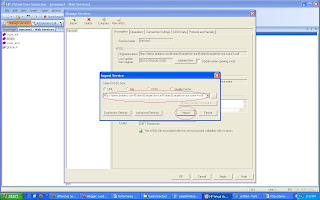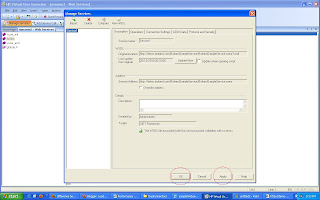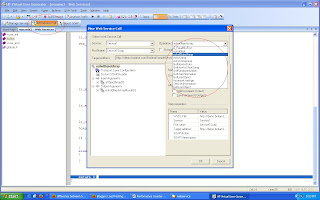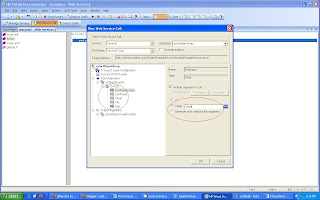Table Of Content
1. Introduction
1.1 Technical Details
1.2 Load Expectations/User Details
1.3 General Details
1.4 Details of performance Testing.
2 Point of Contact /
The Quality of Service attributes like performance, availability, reliability and supportability are becoming an increasingly important measure of project success, gathering performance
Requirements are very important.
The following points are considered while Gathering the Performance Requirements.
1. Application / System Accessibility Method (Intranet Based / Internet Based).
2. What is the GUI used in the system, please provide details about the GUI.
3. Middleware used in building the Application / System (Ex: CPM, DCOM, EJB etc.).
4. What is the Application Server used to run the Business logic?
5. What is the Web Server used to run the Application / System?
6. What are the Transaction Servers? (If any)
7. What are the Proxy Servers the system is using?
8. Provide details about streaming media Servers? (If any)
9. What is the network band width allocated for the application to work?
10. What are the ports Application will be using? Provide details.
11. Provide details about the database used by the application.
12. Is the Application / System is using any Load Balances? If yes, please provide details.
13. What type of data will be transferred from client to server and server to client please provide details?
14. Any encryption method used in the application / System? please provide details.
15. Details of Software used by the Application / System.
16. Details of Hardware on which the Application / System is running.
1. What is the present load on the Application / System, total No. of users using the Application / System?
2. How many concurrent users will be using the Application / System?
3. How many peak users will be using Application / System?
4. How often the peaks are occurring and when it is occurring? Provide details about the peak loads.
5. Network connections and methods used by the users?
6. Provide details about the different types of routers used in the network setup?
7. Number of concurrent connection to test the Application?
8. List the business functions supported by the Application / System?
9. Provide the frequency of the business functions, what are the business functions used frequently by the users?
10. What are the dependencies on other systems?
11. What are the dependencies on system resources?
12. System resources are sharing with any other Application / System?
13. Provide details about the Security requirements which may effect the performance of the Application / System?
14. Any other technical information about the Application which may effect the performance of the Application / System?
Details of Performance Testing required
1. What type of performance testing is required?
ü Load Testing
The application is tested against heavy loads such as testing of web sites in order to find out at what point the web-site/application fails or at what point its performance degrades.
ü Stress Testing
System is stressed beyond its specifications to check how and when it fails. Performed under heavy load like putting large number beyond storage capacity, complex database queries, continuous input to system or database load.
ü Volume Testing
Volume testing is done against the efficiency of the application. Huge amount of data is processed through the application in order to check the extreme limitations of the system.
ü Endurance test
To load the application continuously for certain period to determine resource problems
ü Others (Please specify)
2. Expected duration for test to complete?
3. What are deliverables expected?
4. Is Performance testing currently being done for this system?
ü Yes
ü NO
If yes, what type of testing is done? Used any automation tools? Does the test plan, Test Scripts exists? Please provide details about the acceptance, Suspension and resumption criteria.
ü Is test data available? YES NO
ü Test Script / Scenario available? YES NO
ü Please attach respective documents
ü Baseline Performance measurements available? YES NO
5. What tools are available to perform the testing? If available, how many licenses are available?
6. Documentation is available for the project?
ü Non Functional Requirement
ü Functional Specification
ü System Design and Architecture
ü Others documents (Please Specify)
7. What type of testing currently completed for the Application / System?
8. Is the Application / System functionality is stable? Please provide details
Details of Application / System
1. What is name of Application / System?
2. Please provide brief description about Application / System?
3. What is the architecture of the application / System?
4. What type of Application / System it is? (Ex: Business tool, utility tool etc.)
5. On what operating system this Application / System will run?
6. What is the present status of the Application / System?
ü Initial Stage (Documentation)
ü Designing Stage
ü Development
ü Production
7. This Application / System functioning mode (Front office, Middle Office, Back Office etc.)
8. List of Interfacing Application /System?
9. What is the programming language or Scripting language used to develop the Application / System?
10. Any multimedia objects used (3D Max, Flash, etc.) in the Application?
11. Streaming Media Used (if any) Ex: Windows Media, Real Media etc.
12. Databases (If any please specify)
1. What are the performance testing goals and Objectives?
2. Is Test Data available for performance testing?
3. Performance Test Scripts available for executing Test runs?
4. Performance test plan and test strategy available?
5. Performance test Scenario available?



 Manage service window enter URL (wsdl) and click on Import.
Manage service window enter URL (wsdl) and click on Import.

 Manage service window.
Manage service window.








